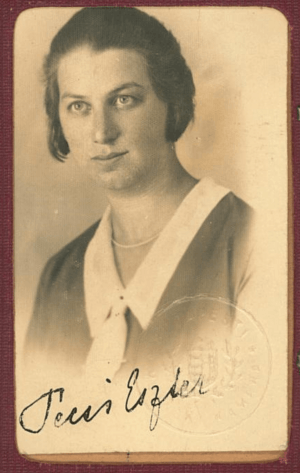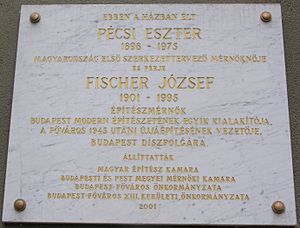Eszter Pécsi facts for kids
Quick facts for kids
Eszter Pécsi
|
|
|---|---|

Pécsi on her Budapest Chamber of Engineers membership card, 1931
|
|
| Born | 8 March 1898 |
| Died | 4 May 1975 (aged 77) |
| Citizenship | Hungarian |
| Occupation | Architect Structural engineer |
Eszter Pécsi (born March 8, 1898 – died May 4, 1975) was a very important Hungarian architect and structural engineer. She was the first woman in Hungary to become a qualified architect. Eszter designed many famous buildings in Hungary, Austria, and America.
Contents
Early Life and Learning
Eszter Pécsi was born Eszter Pollák on March 8, 1898, in Kecskemét, Hungary. Her father, Mór Pollák, was a flour merchant, and her mother was Sarolta Szántó. Eszter was one of seven children, and her family didn't have much money. In 1900, her family changed their last name to Pécsi. Some of her sisters became doctors and a teacher. Her brother, Illés, became an engineer.
Eszter studied at the Royal College of Technology in Berlin, Germany, from 1915 to 1919. In 1918, Hungary changed its laws to let women study at universities. So, in 1919, Eszter returned to Hungary. She finished her studies at the Budapest University of Technology and Economics. On her 22nd birthday, March 8, 1920, she graduated. Eszter Pécsi was the very first Hungarian woman to become a qualified architect! She was one of the first four women to study at that university.
Designing Amazing Buildings
After graduating, Eszter Pécsi worked for ten years at the Guth and Gergely architectural engineering offices in Budapest. She quickly became a senior designer there.
One of her most famous projects was designing the strong concrete arches for the Alfréd Hajós Swimming Pool. This was Hungary's first indoor swimming pool. It was also the largest in Europe at that time. The pool's roof was held up by five huge concrete beams. These beams stretched 31 meters without any support in the middle. The famous Olympic swimmer and architect, Alfréd Hajós, said the hall was "extremely impressive."
Eszter also worked on the foundation for a turbine in Bánhida during these years.
Partnership in Architecture
On December 3, 1922, Eszter married József Fischer, who was also a modernist architect. They had two sons, György and János, who both grew up to be architects too. Eszter and József were part of a group called the Congres Internationaux d’Architecture Moderne (CIAM). This group helped spread modern architecture around the world.
From 1931 to 1948, Eszter and József ran their own architectural company. Eszter was a structural engineer. She designed special "floating" concrete slabs and strong foundations for tall buildings. She also worked on steel structures that were taller than usual. She collaborated with many top Hungarian architects. Her unique designs included the Fiumei út emergency hospital and the Kútvölgyi út hospital. These were some of the first high-rise buildings in Budapest. She also worked on many modern homes.
During World War II, Hungary was part of the Axis powers. Eszter's husband, József, was forced to join the army. But he left the army in 1944 when Germany invaded Hungary. Their home became a safe place for people hiding from danger. This put their family at risk.
After the war, Eszter checked buildings in Budapest that were damaged by bombs. She helped fix the cracked roof of the National Theater.
In 1948, the Hungarian government took control of all businesses. From 1949, Eszter worked for the Ministry of Metallurgy and Mechanical Engineering. She became a chief structural engineer. She worked on a forging workshop for the rail company MÁVAG. She designed a special foundation around an old building. This allowed new parts to be built without stopping the factory's work. She also wrote several articles about her engineering ideas.
Life in a Changing World
Eszter Pécsi and her husband were both members of the Social Democratic Party of Hungary. This party was later stopped by the Soviet government.
In 1956, there was a big revolution in Hungary. People rose up against the government and its Soviet policies. Eszter became involved in the uprising. Her home became a meeting place for politicians from the Social Democratic Party. Her husband, József Fischer, was chosen to lead the party when it started up again during the revolution. On November 3, József was even made a government minister. But the next day, Soviet forces invaded Hungary and stopped the revolution. József had to hide for a while. In 1957, Eszter lost her job because she was involved in the revolution.
New Beginnings in Other Countries
In 1957, Eszter left Hungary without her husband. She lived in Vienna, Austria, for two years. There, she worked for an architectural firm called Krapfenbauer. She designed the structural plans for Vienna's first multi-storey car park near the Vienna Opera House.
Her husband, József, lost his job in 1959. He tried to join Eszter, but the government wouldn't let him leave for seven years.
Eszter then moved to New York, where one of her sons lived. She joined an architectural company called Farkas & Barron as a structural engineer. Later, she worked with Marcel Breuer, a famous Hungarian architect. Eszter then became a Fellow at SOM (Skidmore, Owings and Merrill), one of America's top architectural firms. She helped design the structural plans for the Hotel America (now the Sheraton). This was the tallest reinforced concrete building in New York at the time. She also designed structural plans for tall buildings at Columbia University.
Finally, in 1964, her husband József was able to get a passport and join her in New York. He had waited over seven years!
In 1965, Eszter Pécsi won the "Best Structural Engineer of the Year" award. She received it for a special method she invented. This method allowed tall buildings to be built safely on the banks of the Hudson River.
From 1959 to 1970, she also taught at New York University.
In 1970, Eszter became paralyzed after a serious stroke. Her husband took care of her until she passed away on May 4, 1975, in New York City. Her ashes were brought back to Hungary and buried in Budapest's Farkasréti Cemetery.
Eszter's granddaughter, Zsuzsanna Szabóné Fischer, also became a structural engineer, following in her grandmother's footsteps.
Remembering Eszter Pécsi
To remember Eszter Pécsi, a special plaque was placed on her birthplace in Kecskemét in 2000. Another plaque was placed on the wall of her and her husband's house in Budapest in 2001.
A room at the Budapest University of Technology and Economics was named after Eszter Pécsi. This happened in 2020, 100 years after she graduated as the first Hungarian woman architect.


